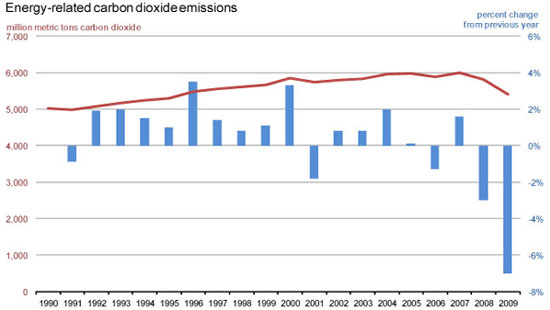According to EIA figures, annual totals of energy-related CO2 emissions fell by 405 million tons during 2009 to 5,405 million tons per year (tpy). Energy-related carbon dioxide emissions account for about 98% of the U.S.' CO2 emissions with most coming from burning fossil fuels and smaller quantities from non-fuel use of fossil fuels, as well as from electricity generation using geothermal and non-biomass waste. Other sources of CO2 emissions include industrial processes, such as cement and limestone production.

"While emissions have declined in three out of the last four years, 2009 was exceptional," the EIA said. The cause of the large drop in emissions in 2009, according to the organization, was the downturn in the economy that caused per capita gross domestic product (GDP) to fall by 3.3%, resulting in a total GDP decline of 2.4%. Energy intensity and the carbon intensity of the energy supply also both fell by more than 2%. These three factors, the EIA said, combined in roughly equal proportions to cause emissions to fall by 7%.
Total emissions of energy-related CO2 fell across all end-use sectors in 2009, with the drop especially pronounced in the industrial sector. The EIA warns that, as the U.S. economy recovers, the structure of that recovery will be important to the future emissions profile of the country. It suggests that, if energy-intensive industries lead the economic recovery, emissions would increase faster than if service industries or light manufacturing play the leading role. If coal rebounds disproportionately, then the carbon intensity of the energy supply could rise above the 2009 level. However, the EIA says, longer-term trends continue to suggest decline in both the amount of energy used per unit of economic output and the carbon intensity of the U.S.' energy supply, which both work to restrain emissions.
In 2009, nuclear energy accounted for 69.3% of US emission-free electricity generation, according to the Nuclear Energy Institute.



























































